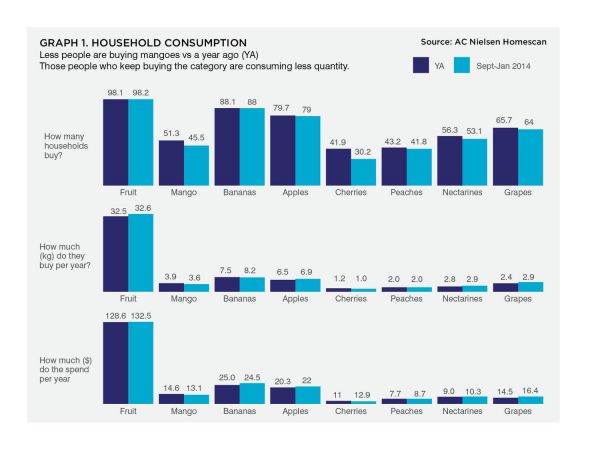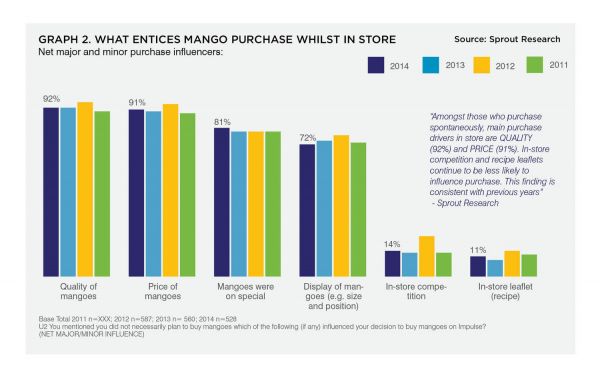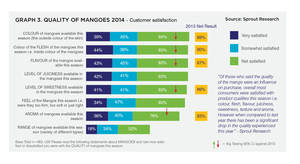Consistent quality— key to retaining mango crown
Published 2014
Each year, the industry undertakes consumer research to help understand how people feel about Australian mangoes. The more we know about our mango buyers, what motivates them to buy, and buy more often, the more successful our marketing will be.
So, what did the consumer research tell us this year?
The research confirmed that mango quality continues to be the number one influence on a person’s decision to buy, closely followed by price, with ‘specials’ becoming increasingly important in the 2013 season. (Graph 1) The relationship between quality and price is all about perceived value. Is the mango on display worth the price being asked? If the answer is ‘no’ people will seek a better deal, actively looking for ‘specials’ wherever possible.

The 2013 research shows that our consumers were less satisfied with their mango experience. According to the ‘Benchmarking’ study conducted by Sprout Research, our product quality was down compared to the previous season on five out of seven quality indicators. These were: colour of the skin; colour of the flesh; flavour; level of sweetness and the range of available mangoes. (Graph 2) Retailers who provided feedback through the in-store merchandising program reported that quality was down, particularly in the early season fruit. Exporters also reported quality issues with over 30% shrinkage this season.

AMIA CEO Robert Gray said that the industry needs to face the fact that the poor quality of early season fruit, coupled with high prices, turned buyers away. “Less people brought mangoes in 2013 compared to the previous season, and those who did buy, bought on less occasions. (Graph 3) How we launch the season has a major impact on our overall performance. Good quality fruit that’s well priced gives our customers permission to indulge and, if the eating experience is good, it’ll underpin the momentum we need for the entire season,” Mr Gray said.

“Consistently delivering a good to great mango experience is the single biggest opportunity our industry has for increasing consumer demand and achieving sustainable, profitable growth. Selling mangoes that look good and taste good is the most important thing we can do because we know that people will pay a higher price for a good quality mango. If our mango buyers are not satisfied with the quality, the price and the combined value of the product we have delivered, then the likelihood of them buying a mango again is significantly lower, and that is what we saw in the 2013 season.
“AMIA are focused on improving the quality of mangoes that consumers see on the shelves, and particular emphasis will be given to this as part of a project that will be managed by AMIA. However, the whole industry needs to come together to achieve the outcome we need,” Mr Gray said.
Mangoes are considered to be an Australian ICON. Their link to summer, fun, Christmas, beach holidays, and good times spent with family and friends has left Australians with unforgettable memories.
AMIA Marketing Manager Treena Welch believes that, as a nation, we consider mangoes to be the ‘King of Fruits’.
“This position is not our birth right, it’s a title we have to earn. Our position is under threat from other summer fruits like cherries, stonefruit, table grapes and the fast growing berry category. To retain the crown we must consistently deliver a good-to-great mango experience from the beginning of the season to the end and everywhere in between,” Ms Welch said.
For more information or a copy of the full research, please contact AMIA.